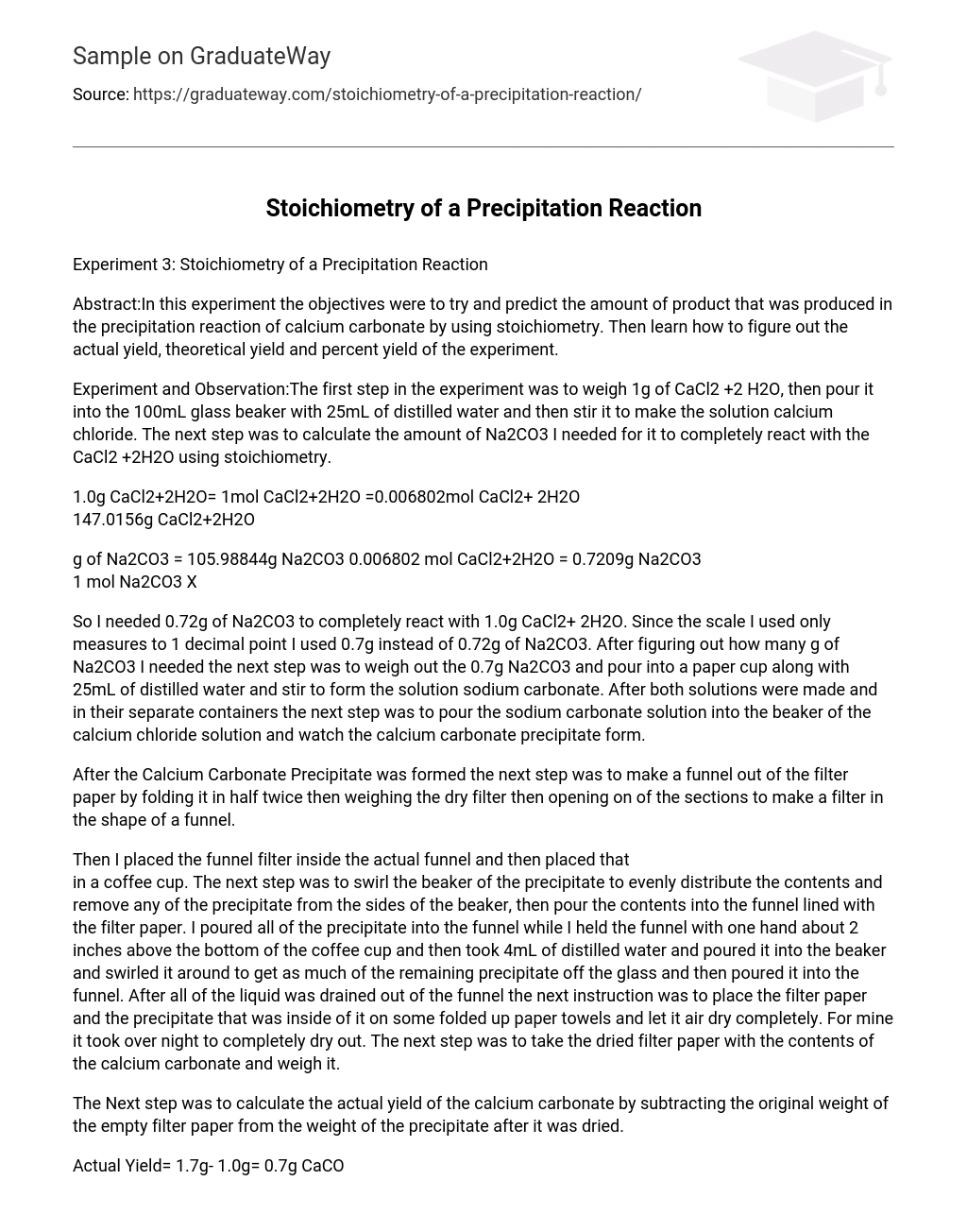Abstract: In this experiment the objectives were to try and predict the amount of product that was produced in the precipitation reaction of calcium carbonate by using stoichiometry. Then learn how to figure out the actual yield, theoretical yield and percent yield of the experiment.
Experiment and Observation: The first step in the experiment was to weigh 1g of CaCl2 +2 H2O, then pour it into the 100mL glass beaker with 25mL of distilled water and then stir it to make the solution calcium chloride. The next step was to calculate the amount of Na2CO3 I needed for it to completely react with the CaCl2 +2H2O using stoichiometry.
1.0g CaCl2+2H2O= 1mol CaCl2+2H2O =0.006802mol CaCl2+ 2H2O 147.0156g CaCl2+2H2O
g of Na2CO3 = 105.98844g Na2CO3 0.006802 mol CaCl2+2H2O = 0.7209g Na2CO3 1 mol Na2CO3 X
So I needed 0.72g of Na2CO3 to completely react with 1.0g CaCl2+ 2H2O. Since the scale I used only measures to 1 decimal point I used 0.7g instead of 0.72g of Na2CO3. After figuring out how many g of Na2CO3 I needed the next step was to weigh out the 0.7g Na2CO3 and pour into a paper cup along with 25mL of distilled water and stir to form the solution sodium carbonate. After both solutions were made and in their separate containers the next step was to pour the sodium carbonate solution into the beaker of the calcium chloride solution and watch the calcium carbonate precipitate form.
After the Calcium Carbonate Precipitate was formed the next step was to make a funnel out of the filter paper by folding it in half twice then weighing the dry filter then opening on of the sections to make a filter in the shape of a funnel.
Then I placed the funnel filter inside the actual funnel and then placed that in a coffee cup. The next step was to swirl the beaker of the precipitate to evenly distribute the contents and remove any of the precipitate from the sides of the beaker, then pour the contents into the funnel lined with the filter paper. I poured all of the precipitate into the funnel while I held the funnel with one hand about 2 inches above the bottom of the coffee cup and then took 4mL of distilled water and poured it into the beaker and swirled it around to get as much of the remaining precipitate off the glass and then poured it into the funnel.
After all of the liquid was drained out of the funnel the next instruction was to place the filter paper and the precipitate that was inside of it on some folded up paper towels and let it air dry completely. For mine it took over night to completely dry out. The next step was to take the dried filter paper with the contents of the calcium carbonate and weigh it.
The Next step was to calculate the actual yield of the calcium carbonate by subtracting the original weight of the empty filter paper from the weight of the precipitate after it was dried.
Actual Yield= 1.7g- 1.0g= 0.7g CaCO3
The next step was to calculate the percent yield using the actual yield and the theoretical yield.
Theoretical Yield= 100.0875g CaCO3 0.00682mol CaCO3 = 0.68g CaC 1mol CaCO3 X
Percent Yield= 0.7g CaCO3 = 1.029 X 100 = 102.9% 0.68gCaCO3
Percent Error = (0.7gCaCO3 – 0.68gCaCO3) = 0.029 X 100 = 2.9% 0.68g CaCO3
Discussion & Conclusion: In this experiment, the percent yield of CaCO3 was found to be 102.9%, the theoretical yield was 0.68g, and CaCO3 and the actual yield was 0.7g CaCO3. The percent error was found to be 2.9%, so since my percent yield was 102.9% and the percent error was 2.9% I can make the conclusion that my experimental measurements were acceptable even though it was over 100%, since 102.9-2.9= 100. It was cool to observe the calcium carbonate precipitate form from the sodium carbonate and calcium chloride solutions being mixed.
Also I enjoyed calculating how much of the sodium carbonate was needed to fully react with the calcium chloride to make the calcium carbonate precipitate. My results were not as expected, I thought my percent yield would be less than 100% instead of over it. It may have been that since the digital scale only reads to one decimal point that my measurements of chemicals was off, like having 0.79g of sodium carbonate and 1.9g of calcium chloride. With these measurements the results would have been slightly over as they were in my experiment. So to achieve better results I would need a digital scale that reads to two decimal points.





